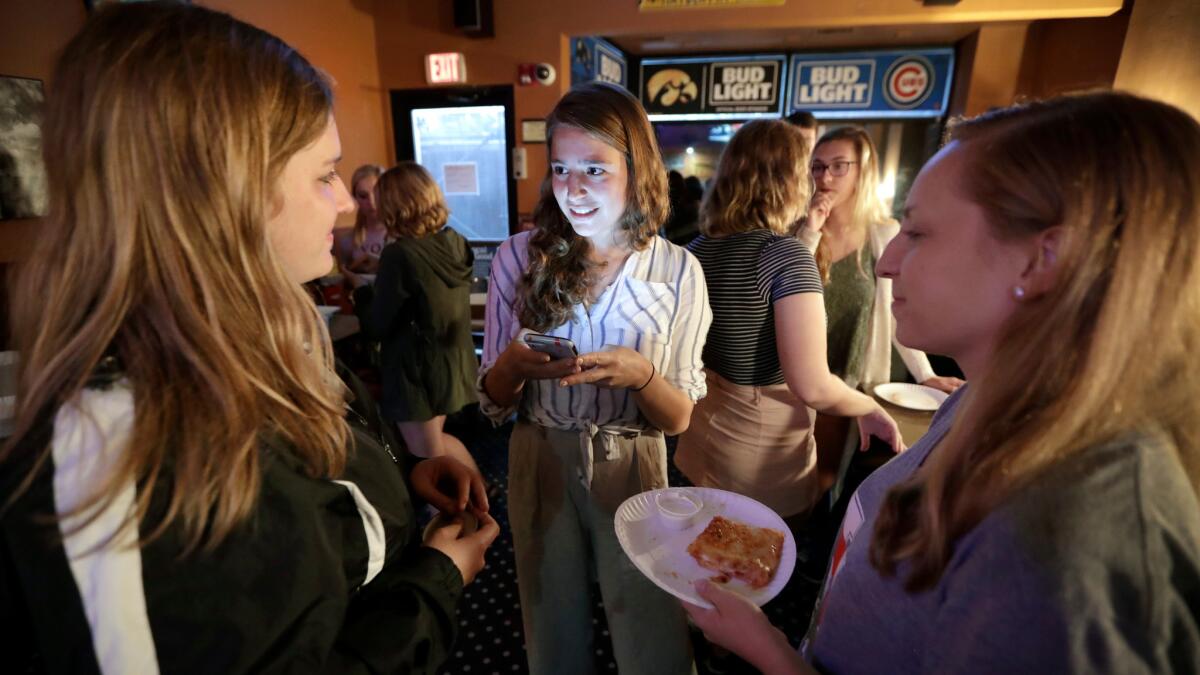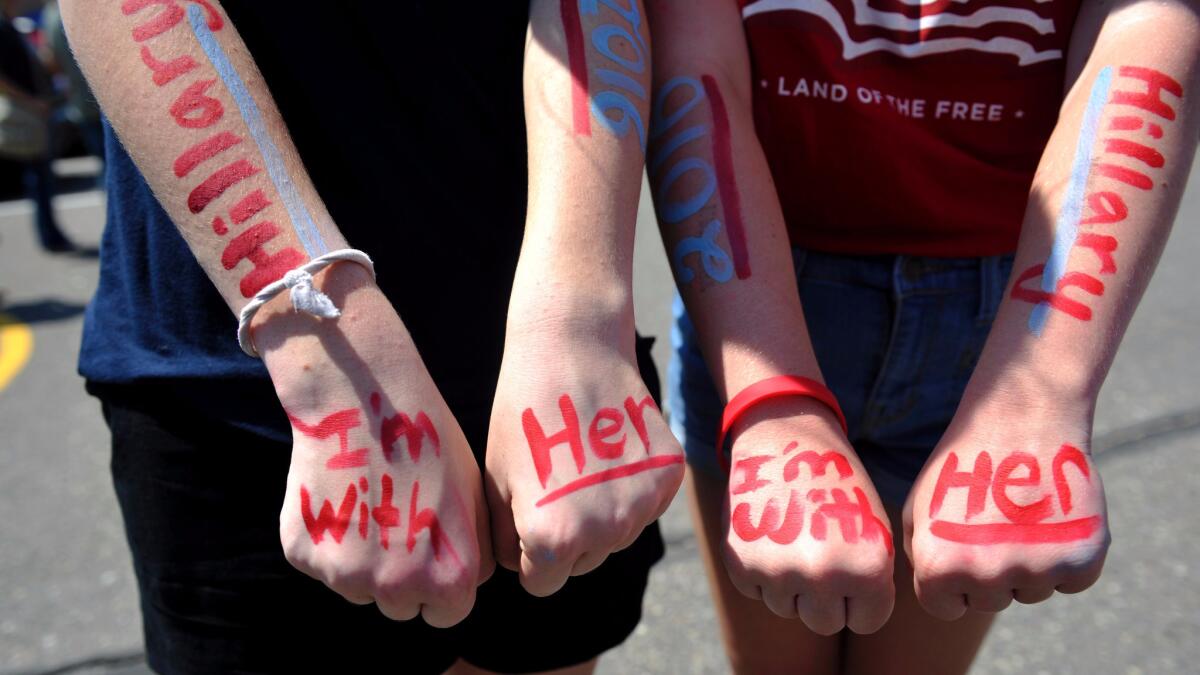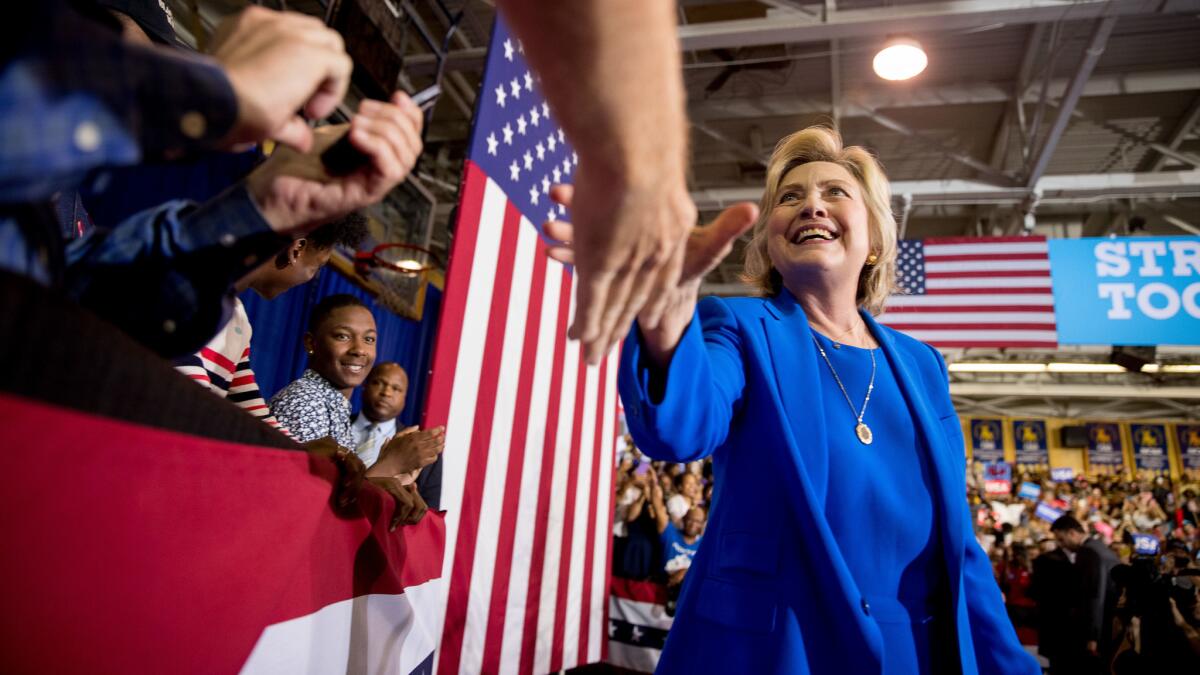Hillary Clinton has millennials’ support, and now she’s trying to make sure they vote

Hillary Clinton is hunting for the votes of millennials. Her campaign is tailgating at a Pennsylvania football game, blasting out Snapchat videos on Florida college campuses and hiring DJs to help register voters in sneaker stores around the country.
It’s a broad, multi-faceted effort ramping up this week intended to boost Clinton’s numbers among voters ages 18 to 35. Polls show her leading Republican candidate Donald Trump among millennials, but there is uncertainty about whether they will turn out in large enough numbers to secure victory in key battleground states.
On a conference call with students last week, she urged them to prepare for a grinding get-out-the-vote effort to beat Trump.
“No matter what the polls say ... this is going to be close,” Clinton said.
Clinton portrayed her candidacy not only as a vehicle for progressive policies like debt-free college education that her campaign sees as important to young voters, but also an opportunity to reject Trump’s divisive rhetoric.
“The hatred and bigotry we’ve been hearing from the candidate on the other side goes against what our country, and young people especially, stands for,” she said. Clinton has hammered that message for months, though she was forced to apologize Saturday for saying “half” of Trump supporters fit in what she called a “basket of deplorables” — racists, sexists, xenophobes and others with bigoted views.
Millennials rival baby boomers as the largest generational segment of the country’s electorate. Each makes up nearly one-third of voters, according to the nonpartisan Pew Research Center.

Compared with voters overall, millennials are more likely to be liberal and less likely to be white. Among millennials, Clinton’s support is strongest among blacks, Latinos and Asians, according to a study by GenForward, a survey conducted by the Black Youth Project at the University of Chicago.
And in closely fought states where Clinton is looking to erase Trump’s advantage with white men, they’re clustered in key urban areas like Philadelphia, where President Obama will campaign on her behalf Tuesday. Other battlegrounds where young voters could decide the outcome are Iowa and New Hampshire, according to a report from the Center for Research and Information on Civic Learning and Engagement at Tufts University.
Out of all the states on the Tufts list, the millennial generation in Florida is the most diverse, with nearly half of voters under 30 either black or Latino.
“Hillary Clinton has to run the score up in places like Miami and Orlando,” said Steve Schale, a Democratic strategist who worked for Obama in Florida during both his presidential runs. “That’s where she’s going to go to war.”
He added, “The slightest change in turnout could skew the election a point or two, and that’s the margin you need to win.”
Get the latest news from the campaign on Trail Guide »
Obama won 60% of voters under 30 in 2012; a recent SurveyMonkey analysis showed Clinton only a few points behind that level among voters under 35.
However, millennials were less certain of their decision than older generations. In addition, a USC Dornsife/Los Angeles Times poll showed young voters in California were more willing to consider third-party candidates — not a problem in such a solid blue state, but a potential warning sign if the trend extends to battlegrounds.
And the vibe among millennials is much different than when Obama was running in 2008, said Anna Eskamani, a 26-year-old faculty advisor for the College Democrats at the University of Central Florida in Orlando.
“We don’t have that ‘yes we can’ mentality,” she said, citing Obama’s informal slogan. “It’s a different type of energy.”
Eskamani added, “It’s rooted in this dynamic that Trump is dangerous.”
The challenge is convincing young voters exasperated by congressional gridlock and disillusioned by the lingering effects of the Great Recession that their vote can have an impact.
Millennials can feel like “anything they do isn’t going to make things better,” Eskamani said. “We have to break that.”
To that end, Clinton’s campaign is pursuing each demographic with its own curated appeal.
The campaign is holding “black girl magic” meetings, a theme of empowerment for young black women. Asian supporters have hosted #BubbleTeaforHillary events. Clinton also has deep ranks of celebrity Latino supporters, including actress Eva Longoria and singer Marc Anthony.
“There’s no cookie-cutter version of a millennial,” said Jamira Burley, the campaign’s deputy millennial vote director.

After young voters favored Sen. Bernie Sanders of Vermont in the primary, Clinton’s team wants them to give the former secretary of State a second look by showing she feels just as deeply about addressing climate change, college affordability and criminal justice issues.
“This campaign is a home for them,” said Addisu Demissie, Clinton’s national voter outreach and mobilization director.
Priorities USA, a super PAC supporting Clinton, on Monday launched an online video series highlighting Trump’s denial of climate change, his suggestion (since retracted) that women could be punished for having abortions and his interest in heavily cutting the U.S. Department of Education.
Ben Tulchin, a San Francisco-based pollster for Sanders, believes young voters are transferring their support to Clinton even if they lack the enthusiasm for her that they once expressed for the septuagenarian senator.
“It takes time. Bernie was their true love,” he said. “They fell for him. It didn’t work out. They had to grieve.”
He pointed to public polls that showed Clinton leading Trump by 20 to 30 points nationally among young voters, a gap he said indicated that Sanders supporters had come around to Clinton.
One hurdle is making sure young voters are registered. Not only are they already less likely to vote than older generations, they’re also more likely to be moving from place to place.
So even if people voted in 2012 on their college campuses, the campaign wants to make sure they’re signed up to vote where they’re living now.
“We are very, very mobile,” said Sarah Audelo, the campaign’s youth vote director. “We have to find them and make sure their registrations are up to date.”
Twitter: @chrismegerian
Coasting is no longer an option for Hillary Clinton, given Donald Trump’s resilience
‘I’m just lost.’ Voters find it hard to commit to Clinton or Trump
Updates from the campaign trail
More to Read
Get the L.A. Times Politics newsletter
Deeply reported insights into legislation, politics and policy from Sacramento, Washington and beyond. In your inbox three times per week.
You may occasionally receive promotional content from the Los Angeles Times.











